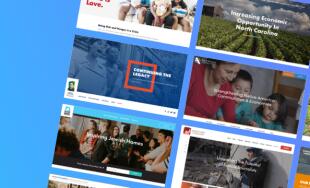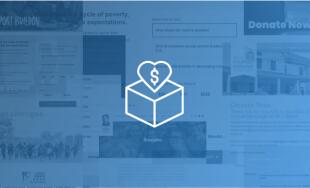Oftentimes, SEO is thought of as only relevant to businesses, trying to outgame competitors for specific terms to win new clients. However, SEO can be a critical tactic for nonprofits to boost their brand awareness, highlight details around the issues for which they advocate, and to raise money online through online contributions. While nonprofits may sometimes not think of themselves as “competitors,” the quest to earn contributions and promote their work in the face of other nonprofits is very much a competition, and one for which search engine optimization can be a very valuable tool.
The strategies that align with SEO fit perfectly with the nature of nonprofits -- telling compelling stories about important topics and working to elevate that voice and point of view. Below, I work to elaborate on that in lengthy detail.
Why Should Nonprofits Care About SEO?
We work as a nonprofit web design firm for groups across the country, and essentially all of our clients now have an understanding of some basics for why they should care about SEO. That basically boils down to if someone is looking for their name, team, core programs, or other related information about the specific organization, they want to rank highly. People should be able to find directions to their location, learn more about a teammember they just interacted with, or find a specific program they were just exposed to.
That part is easy to get and easier to achieve -- rank for branded terms, even if somewhat loosely branded (e.g., a boardmember’s name). It’s important to show up for the content you “own” and can be valuable to draw people in and further engage with the organization.
Where we really try to make an impact with nonprofits is helping them broaden their SEO scope and funnel, targeting unbranded terms that are relevant, but not singularly specific, to the organization. This approach does seem more “competitive” than many nonprofits typically think of themselves, but it can do a great service for both the organization and your causes.
While it’s always great when an organization has the brand recognition and mindshare to have prospects searching for their specific name or program, what often happens online is that someone is searching for a general topic that they have an interest in learning about, volunteering for, or contributing to. This is especially true as action and donations have continued to move online, and even moreso during the COVID pandemic.
When someone first reads about a topic, such as racial injustice, and wants to make a local impact, they’ll often times either search for a broader term with a local qualifier, such as their city or county name. Using our friends at the Community Foundation of Lorain County as an example, they understand that someone may be searching for a broader term like “racial equity,” which is why they’ve gone to great lengths to create pages not just for their specific racial equity fund, but also a number of different resources on the topic of racial equity. They create this content to document and promote the wonderful work they do, but a side-benefit of that content is the value in ranking for these terms, especially for geographic-specific terms, and surfacing helpful content for searchers that engages them with the organization.
I experienced the value of nonprofit SEO first-hand during the 2021 Texas Power Outage Crisis. I wanted to contribute and help, but living more than 1,000 miles away made it hard to know the right causes to give to. I checked with friends in Texas, and I also did broad Google searches about mutual aid groups in austin, paying power bills in texas, and more to get an understanding of who was working to address the crisis and how I could help.
These broad, unbranded terms are critical for nonprofits to get in front of motivated and engaged donors who are looking for good groups to support. That’s the why, but what you’re almost certainly asking now is: how do we get our content to rank in search engines as a nonprofit?
SEO Tips for Nonprofits
Now understanding the importance of why nonprofits should care about SEO, I wanted to provide some tips for how nonprofits can improve their search engine optimization efforts. There are three high level factors to control for, in no particular order:
- Technical
- On-site content
- Off-site links
Google keeps their algorithm top-secret, as it’s the foundation of their Trillion dollar business, but they do make some aspects public. What we know it boils down to is that Google wants to send visitors to reputable, knowledgeable sites that also provide a great experience for visitors. The way they know a site is reputable and knowledgeable is based on the links from external sites that “vouch” for the site by pointing to it and by crawling the content to make sure the site has some depth of knowledge about the topic. They also figure that the more knowledgeable a site proves, the more links from others it will earn. Below are some quick tips on helping your nonprofit improve your SEO efforts and search engine rankings.
Check your speed and get the technical basics right. While we don’t know a ton about what Google looks at under the hood, we do know that they prioritize sites that load quickly, work well on mobile, and provide a smooth user experience for visitors. After all, Google wants to send people to sites that feel trustworthy, reputable, and provide a solid experience, encouraging those people to use Google again in the future.
To get an immediate, rough and quick benchmark for how your site performs, use the Google PageSpeed Insights tool. It will give you a grade from 0-100, and while there is a lot of nuance packed into that number, it’ll get you a quick, fair assessment of the general standing of your site and also provide tips for how to fix it. Google is now exposing more of that nuanced data in their Core Web Vitals tools and assessments, and they acknowledge that this will be the primary metric used going forward by around May of this year. Both tools will likely need a developer to fix the issues, and CWV may require a developer to decipher the reports, but they’ll give even a web novice an idea of how a site is performing. You can read our previous post looking at how to understand the data in Core Web Vitals and Google PageSpeed Insights, and what you should do about it.
In addition to the performance, which often requires use of third-party validation tools, there are a couple of other easy things to look for on your site. First, does it work well on mobile devices and others. Google is on the record saying they give ranking preference to sites that work well on mobile, so it’s critical that you provide a solid mobile experience.
Second, make sure that your URLs are clean, easy to read for a human, and contain keywords in line with your title and content. You’ll see in our Community Foundation of Lorain example that their URL https://www.peoplewhocare.org/resources/racial-equity-fund-provides-grants-to-fight-racism is easy to decipher and contains keywords relevant to the topic they want to rank for.
Finally, on your pages, make sure that you’re using headlines to separate content and call out different sections, linking to relevant pages by using content about the page and not just “click here,” and that your text on the page can be read and discerned by a machine (e.g., it’s not all stuffed in a PDF).
There are countless other ways to make sure that your nonprofit’s technical build is helping your search engine optimization, but following the basics above will put you on strong footing.
Create relevant, quality content to your unbranded terms and establish a publishing schedule. Now that you know your website is on firm footing technically, it’s essential to take advantage of that foundation and start to build content on top of it. Google looks at the content across a website to understand what that organization is an expert in and then works to rank individual pages around that content.
So, the more content you create, the stronger you position yourself in Google’s eyes on different topics and the better opportunity you have for individual pages to rank. The more content created related to the topic across the site signals to Google that it’s an issue the organization cares about and has a unique capability in. Furthermore, working to link the different pieces of content together through Related Resources and nesting relevant pages under one another will help Google more quickly crawl the site and understand the related content and depth on the topic.
This approach creates a depth of knowledge and expertise on the site that Google picks up on and incorporates into its understanding. Additionally, the breadth of the content allows for different ranking opportunities. Google ranks each individual page, meaning that each individual resource and press release presents a unique ranking opportunity. Because of this, they should not compete against each other too much and work to cleave off even smaller, focused subsections of the topic. Each of these can accrue ranking on their own; so, an organization should create content to the specific sub-areas or initiatives related to a particular issue in order to rank for those specific, longtail terms.
While it takes work to create this content, it also pays off. Not only in having the additional content for Google to crawl and rank, but the search engine also gives preference to sites that are more frequently updated. We see this in our own work all the time -- if you update your site more, you’ll get crawled more, and benefit in the rankings. By creating any type of content, you’ll be encouraging Google to come back, learn more about you, and rank you more highly.
Ultimately, the goal is to create a web of content related to the different issues or focuses of the nonprofit, picking off a number of different terms. Additionally, each piece of that web should also link back to the main issue/topic page, which we call a Pillar Page, building that top level awareness for the broader, more competitive term. By doing this often, you’ll not only have a wealth of content, but you’ll signal to Google that you’re an evolving resource that they should frequently visit and reassess in the rankings.
Get links built to your content to vouch for its quality to Google. The two pieces above are focused around on-page SEO, meaning things that an organization can fully control on their site. You’re in charge of the quality of the build and performance of the site in, and you can also make sure that quality content is created frequently. We now move into the area that’s frequently thought of as off-page SEO, which is getting links built into this content.
Links are the currency of the web. They’re the original underpinning of Google’s brilliance and dominance -- look at what other people say is good content, trust them, award more credit to the most authoritative of linkers, and use that to understand a site’s importance. It’s rooted in the world of academia; the more a research paper is cited by others, the more authoritative and groundbreaking that paper is considered by respected peers. It’s an easy concept, but hard to master. It’s not like the New York Times is just handing out links to anyone!
The first thing here is to stress that the links you build in should be legitimate. There are countless vendors and sales people who will promise to get you listed in different directories, trade links, sell priority post inclusions, etc. Google is smart. They know about these services and are actively working to discredit these “black hat” sites in their own algorithm. You’ll likely get no benefit or even penalized by trying to take a shortcut.
So, how does an organization, especially a new one, earn these coveted links. The first step is related to the the section above -- consistently create quality content! If you’re creating good content, make sure to promote it across social media, email lists, and more. People will find this content and link to it. Social links are a separate category in Google’s score and an important one, too. Also, even if you’re shouting you’re quality content into the void and earning no links or shares, by frequently creating it, Google will visit you more and rank you. One of those pieces of content can hit in the rankings and then earn more links. It ultimately boils down to the quality of content -- write things people want to read and share -- but the quantity can help the machines play their role, too.
Also, don’t neglect your own internal power for the initial boost. Start with your partners and ask them to give you a link from their own sites. Then, ask board members to link from their corporate sites or even their social media profiles. Each of these links will help build the overall link profile of your organization and ultimately help you rank for terms on your site.
Relatedly, don’t ignore cross-linking on your own site. As you create new content, make sure to have links within that content to other things you’ve written or your priority initiatives. These links are not only helpful wayfinding devices for visitors to that content, but Google also gives you credit for your own links! They also penalize you if you get spammy with the links -- so, be thoughtful and considerate and link to content where it’s a natural fit. Also, within those links, always be sure to use descriptive anchor text rather than just saying to click here. That anchor text is what Google uses to understand what a page is about; for example, write “a guide on writing website RFPs for nonprofits” rather than saying “click here to read our guide.”
By creating frequent content, sharing it, and leveraging your own internal power, you can start to create a flywheel effect where people find your content on their own, link to it, and help you rank for more and more terms.
Conclusion
The important takeaway here is that search engine optimization is a tool that should be wielded by nonprofits. You have a story to tell about issues that are critically important to others. Tell that story, share that content, and attract new visitors who want to support your mission and organization. And if you have more questions on how to best do this, we’re here to help :).




Leave the first comment